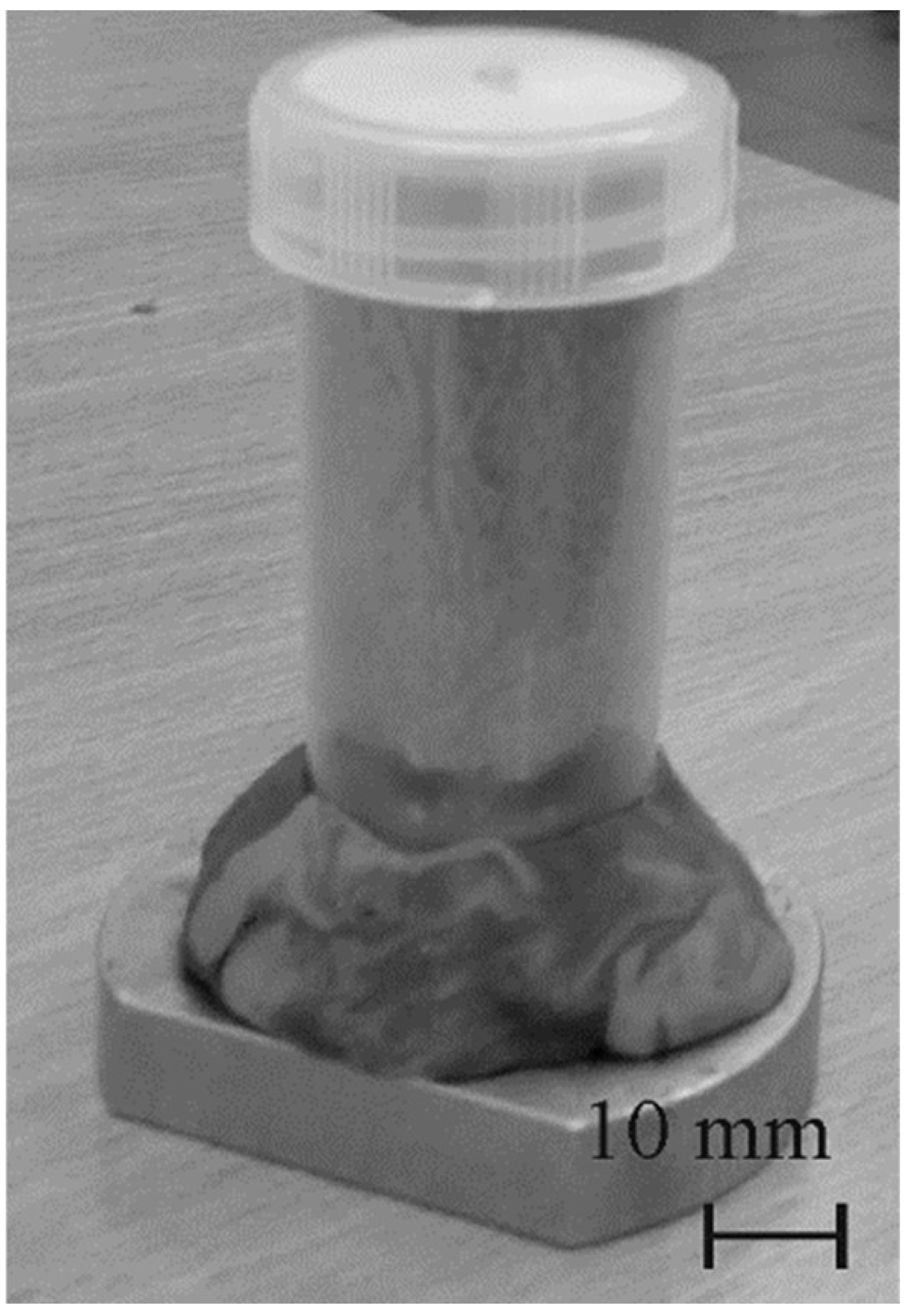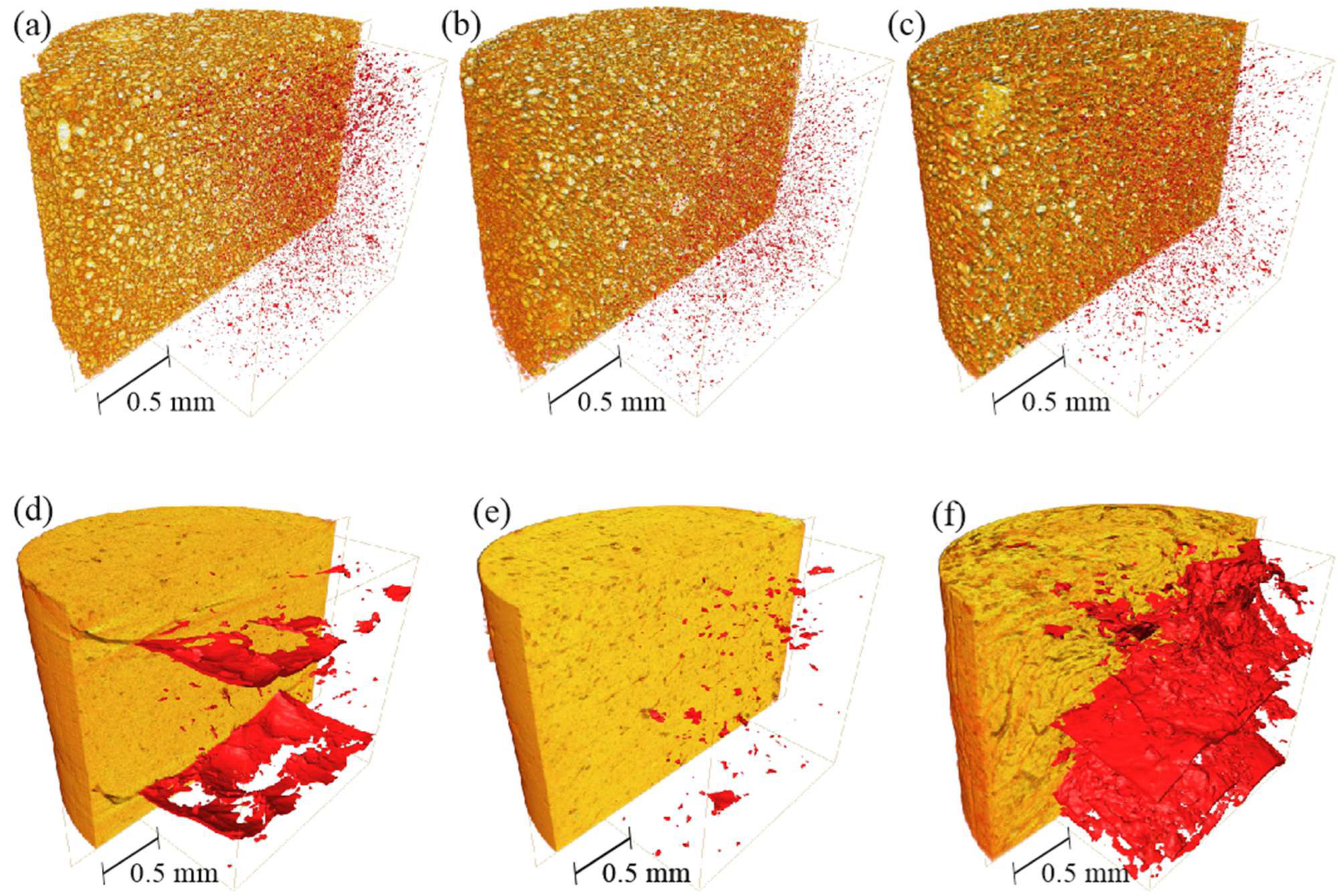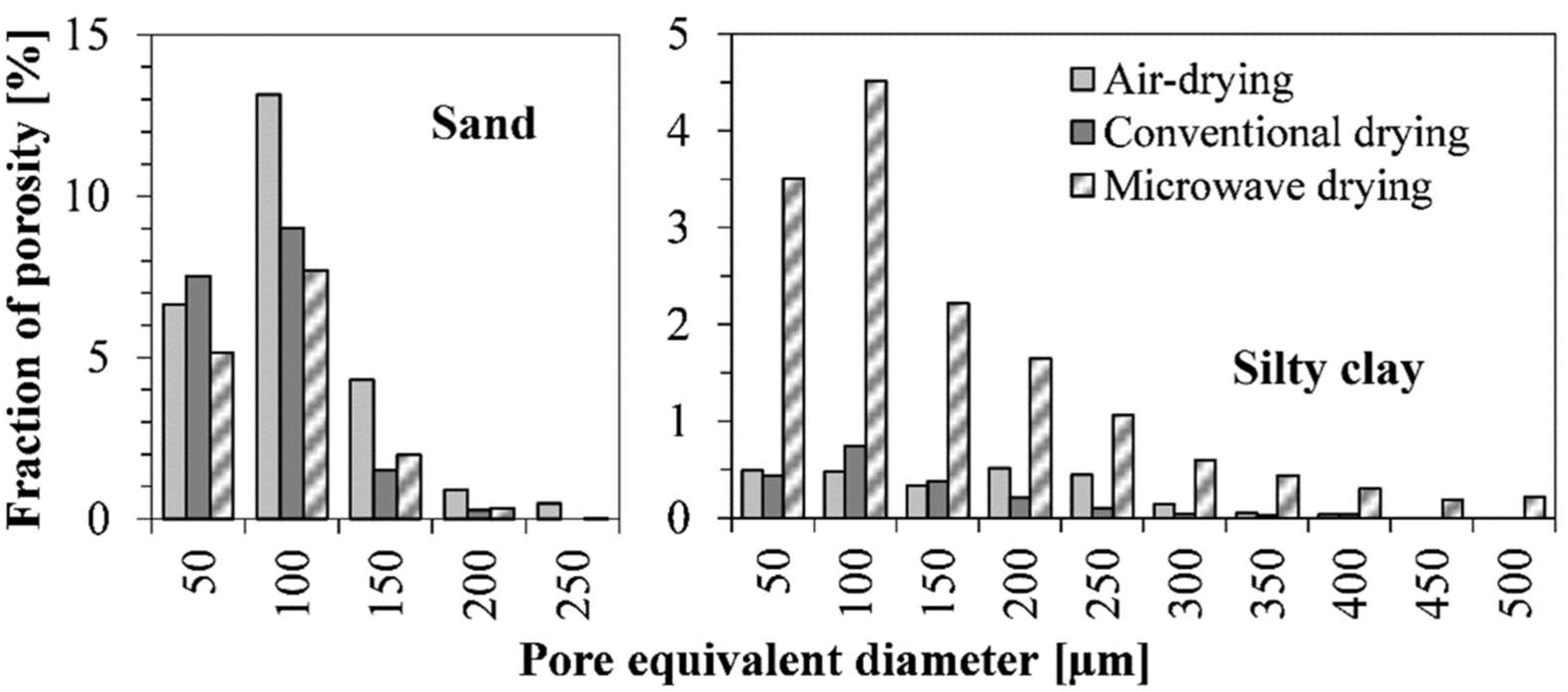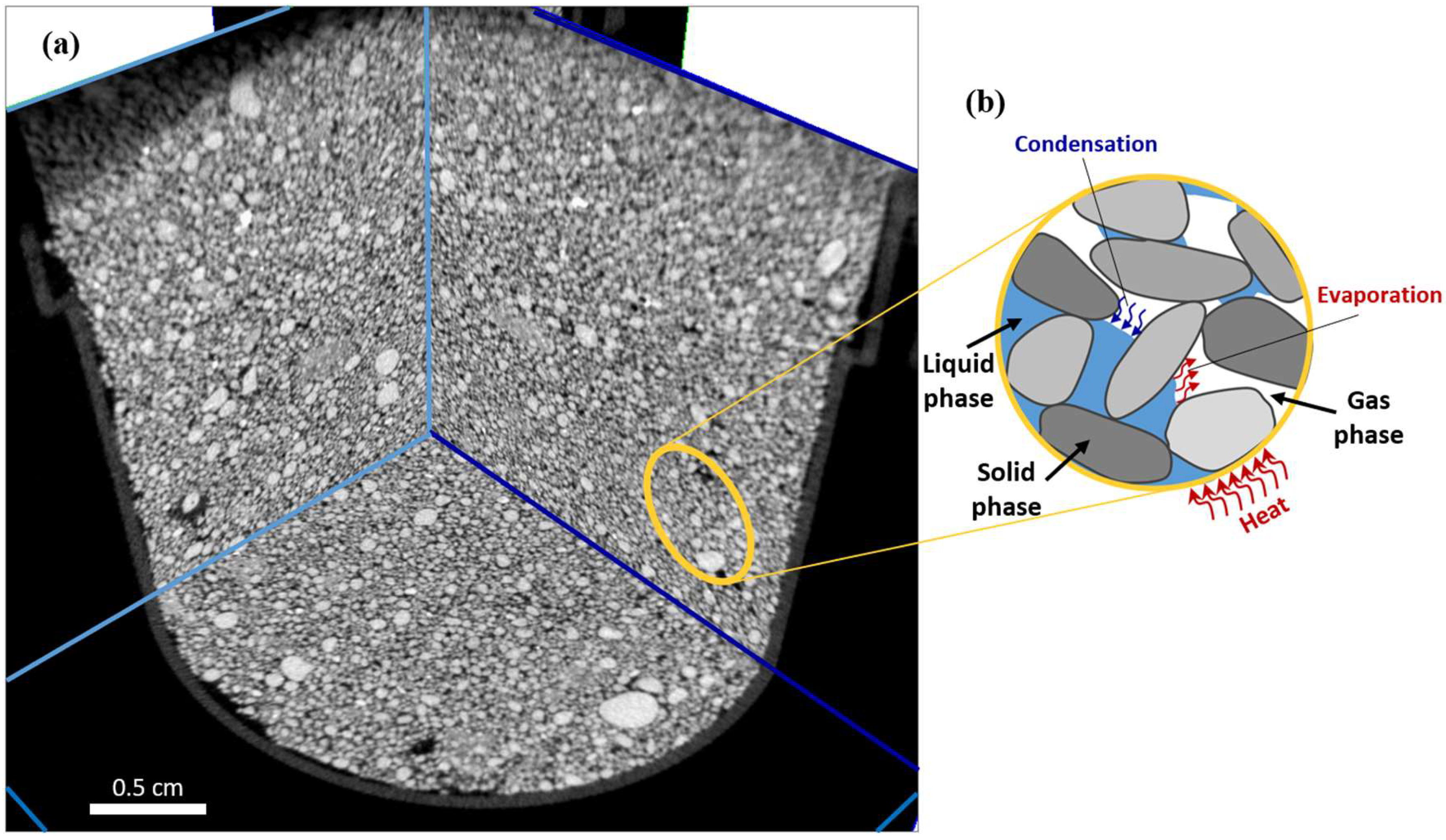The Impact of Microwave Drying on the Structure of Exemplary Soils—Insights Using X-ray Microtomography
Abstract
:1. Introduction
2. Materials and Methods
2.1. Selected Soils and Their Preparation
2.2. Procedure of Soil Drying by Air, Oven, and Microwave
2.3. X-ray Computed Microtomography
3. Results and Discussion
4. Conclusions
- Silty clay, as a cohesive soil, is significantly more sensitive to drying processes than the non-cohesive sand sample. The results obtained in this research showed severe fracturing of silty clay for MO-dried samples. In the case of sandy material, MO drying was successfully applied. The grains of the samples with relatively low water content used in the study did not crack. Thus, the heating type (CO or MO) is not interchangeable in the presented case of the selected cohesive soil. Further studies with different water contents combined with XµCT analyses are recommended.
- Uncritical use of MO drying in laboratories (due to the significant reduction in drying time) may result in incorrectly determining the mechanical and filtration parameters of the soils. The impact of microwaves on the soil during the study of basic physical properties, and then using the same soil for testing shear strength or water permeability, can cause a change in these characteristics. In the case of their reduction, they are underestimated, and in the case of their increase, they are overestimated. As a result, this may cause additional costs associated with the desire to unnecessarily improve their specific characteristics, or there may be a risk of construction failure.
- The drying method had a considerable effect on the porosity of the treated samples. After CO drying, the porosity was 28% lower than after air drying. In MO drying, porosity was even 40% lower than after air drying. This is related to the soil skeleton response to rapidly evaporating water.
Author Contributions
Funding
Institutional Review Board Statement
Informed Consent Statement
Data Availability Statement
Acknowledgments
Conflicts of Interest
References
- Zhu, B.; Ye, Z.; Wang, L.; Kong, D.; Xu, W.; Kolditz, O.; Nagel, T.; Chen, Y. Hydro-mechanical Behavior of Unsaturated Soil Surrounding A Heated Pipeline Considering Moisture Evaporation and Condensation. Comput. Geotech. 2020, 119, 103377. [Google Scholar] [CrossRef]
- Ying, Z.; Cui, Y.; Benahmed, N.; Duc, M. Changes of Small Strain Shear Modulus and Microstructure for a Lime-Treated Silt Subjected to Wetting-Drying Cycles. Eng. Geol. 2021, 293, 106334. [Google Scholar] [CrossRef]
- Zhang, Z.; Yang, J.; Yue, J.; Li, W.; Gao, H. Research on the Mechanism and Prevention Methods of the Drying Shrinkage Effect of Earthen Sites. Materials 2022, 15, 2595. [Google Scholar] [CrossRef] [PubMed]
- Sayem, H.M.; Kong, L. Effects of Drying-Wetting Cycles on Soil-Water Characteristic Curve. In Proceedings of the International Conference on Power Engineering & Energy, Environment, Shanghai, China, 21–23 October 2016. [Google Scholar]
- Rao, S.M.; Revanasiddappa, K. Influence of Cyclic Wetting Drying on Collapse Behaviour of Compacted Residual Soil. Geotech. Geol. Eng. 2006, 24, 725–734. [Google Scholar] [CrossRef]
- Jastrzębska, M. Practical Application of the Microwave Oven in the Geotechnical Laboratory. Archit. Civ. Eng. Environ. 2019, 12, 91–104. [Google Scholar] [CrossRef]
- Prokopowicz, P.; Pires, P.; Michałek, A.; Rybak, A.; Khairutdinov, A.M. Time necessary for microwave drying of mineral soils. J. Phys. Conf. Ser. 2020, 1614, 012021. [Google Scholar] [CrossRef]
- Lin, L.C.; Benson, C.H. Effect of Wet-Dry Cycling on Swelling and Hydraulic Conductivity of GCLs. J. Geotech. Geoenviron. Eng. 2000, 126, 40–49. [Google Scholar] [CrossRef]
- Wang, B.; Zhang, C.; Qiu, X.; Ji, E.; Zhang, W. Research on Wetting-Drying Cycles’ Effect on the Physical and Mechanical Properties of Expansive Soil Improved by OTAC-KCl. Adv. Mater. Sci. Eng. 2015, 6, 304276. [Google Scholar] [CrossRef]
- Louati, F.; Trabelsi, H.; Mehrez, J.; Tabibi, S. Wet-dry cycles effect on the saturated hydraulic conductivity. In Proceedings of the 7th International Conference on Unsaturated Soils, Hong Kong, China, 3–5 August 2018. [Google Scholar]
- Zhao, S.; Shi, Z.; Peng, M.; Bao, Y. Stability Analysis of Expansive Soil Slope Considering Seepage Softening and Moistening Expansion Deformation. Water 2020, 12, 1678. [Google Scholar] [CrossRef]
- Consoli, N.C.; Scheuemann, F.; Segadães, L.; Cristelo, N. Effect of wet-dry cycles on the durability, strength and stiffness of granite residual soil stabilised with Portland. In Proceedings of the XVII European Conference on Soil Mechanics and Geotechnical Engineering, Reykjavik, Iceland, 1–6 September 2019. [Google Scholar] [CrossRef]
- Xu, X.; Shao, L.; Huang, J.; Xu, X.; Liu, D.; Xian, Z.; Jian, W. Effect of Wet-Dry Cycles on Shear Strength of Residual Soil. Soils Found. 2021, 61, 782–797. [Google Scholar] [CrossRef]
- Khan, S.; Ivoke, J.; Nobahar, M. Coupled Effect of Wet-Dry Cycles and Rainfall on Highway Slope Made of Yazoo Clay. Geosciences 2019, 9, 341. [Google Scholar] [CrossRef]
- Gowthaman, S.; Nakashima, K.; Kawasaki, S. Effect of Wetting and Drying Cycles on the Durability of Bio-Cemented Soil of Expressway Slope. Int. J. Environ. Sci. Technol. 2021, 19, 2309–2322. [Google Scholar] [CrossRef]
- PN-EN ISO 14688-2:2006; Geotechnical Investigation and Testing. Determination and Classification of Soils. Part 2: Classification Rules. PKN: Warszawa, Poland, 2006. (In Polish)
- Gilbert, P.A. Computer Controlled Microwave Oven System for Rapid Water Content Determination. Technical Report GL-88-21; Department of the Army Waterways Experiment Station: Vicksburg, MS, USA, 1988. [Google Scholar]
- Skempton, A.W. The colloidal activity of clays. In Proceedings of the Third International Conference on Soil Mechanics and Foundation Engineering, Zurich, Switzerland, 16–27 August 1953. [Google Scholar]
- Jastrzębska, M. The External and Internal Measurement Effect on Shear Modulus Distribution within Cyclic Small Strains in Triaxal Studies on Cohesive Soil. In Proceedings of the International Conference on Experimental Mechanics ICEM, Poitiers, France, 4–9 July 2010. [Google Scholar] [CrossRef]
- PKN-CEN ISO/TS 17892-1:2009; Geotechnical Investigation and Testing. Laboratory Testing of Soil—Part 1: Determination of Moisture Content. PKN: Warszawa, Poland, 2009. (In Polish)
- ASTM D 2216-19:2019; Standard Test Methods for Laboratory Determination of Water (Moisture) Content of Soil and Rock by Mass. ASTM International: Philadelphia, PA, USA, 2019.
- ASTM D4643-00:2000; Standard Test Method for Determination of Water (Moisture) Content of Soil by Microwave Heating. ASTM International: Philadelphia, PA, USA, 2000.
- ASTM D4643-08: 2008; Standard Test Method for Determination of Water (Moisture) Content of Soil by Microwave Heating. ASTM International: Philadelphia, PA, USA, 2008.
- AS 1289.2.1.4:2015; Methods of Testing Soils for Engineering Purposes. Method 2.1.4: Soil Moisture Content Tests—Determination of the Moisture Content of a Soil—Microwave-oven Drying Method (Subsidiary Method). Standards Australia: Sydney, Australia, 2015.
- AS 1289.0:2014; Methods of Testing Soils for Engineering Purposes. Part 0: Definitions and General Requirements. Standards Australia: Sydney, Australia, 2014.
- NF P 94-049-1:1996; Soils: Identification and Testing–Determination of Water Content in Materials–Part 1: Microwave Oven Drying Method. AFNOR Normalisation: La Plaine Saint-Denis, France, 1996. (In French)
- ATT 15/96 Moisture Content. Part IV. Microwave Oven Method. Available from Alberta Transportation Test Procedures. 1996. Available online: www.transportation.alberta.ca (accessed on 19 August 2022).
- Chung, P.; Ho, T. Study on the Determination of Moisture Content of Soils by Microwave Oven Method. GeoReport No.221; Civil Engineering and Development Department of Hong Kong: Hong Kong, China, 2008. [Google Scholar]
- PKN-CEN ISO/TS 17892-12:2009; Geotechnical Investigation and Testing—Laboratory Testing of Soil—Part 12: Determination of Atterberg Limits. PKN: Warszawa, Poland, 2009.
- Solonenko, L.I.; Repiakh, S.I.; Mamuzić, I.; Kimstach, T.V.; Bilyi, O.P. Kinetics of quartz sand and its mixtures drying by microwave radiation. Nauk. Visnyk Natsionalnoho Hirnychoho Univ. 2021, 1, 68–77. [Google Scholar] [CrossRef]
- Gee, G.W.; Dodson, M.E. Soil water content by microwave drying: A routine procedure. Soil Sci. Soc. Am. J. 1981, 45, 1234–1237. [Google Scholar] [CrossRef]
- Stanevich, V.T. Building Ceramics—Tutorial. Kereku Publishing Press: Pavlodar, Kazakhstan, 2009; pp. 1–96. [Google Scholar]
- Kramarenko, V.V.; Nikitenkov, A.N.; Yu Molokov, V.; Shramok, A.V.; Pozdeeva, G.P. Application of Microwave Method for Moisture Determination of Organic and Organic-Mineral Soils. In IOP Conference Series: Earth and Environmental Science; IOP Publishing: Bristol, UK, 2016; Volume 33, p. 012040. [Google Scholar] [CrossRef]
- Kawala, Z.; Atamańczuk, T. Microwave-Enhanced Thermal Decontamination of Soil. Environ. Sci. Technol. 1998, 32, 2602–2607. [Google Scholar] [CrossRef]
- Shang, H.; Robinson, J.P.; Kingman, S.W.; Snape, C.E.; Wu, Q. Theoretical Study of Microwave Enhanced Thermal Decontamination of Oil Contaminated Waste. Chem. Eng. Technol. 2007, 30, 121–130. [Google Scholar] [CrossRef]
- Cormick, A. Comparing Different Heating Methods for Determination of Moisture Content in Soils. Ph.D. Thesis, University of Southern Queensland, Toowoomba Qld, Australia, 2015. [Google Scholar]
- Gołębiewska, A.; Połoński, M.; Witkowski, M. Determination of Water Content of Soil by Microwave Oven Method. Acta Sci. Pol. Archit. 2003, 2, 63–78. [Google Scholar]
- Jalilian, J.; Moghaddam, S.S.; Tagizadeh, Y. Accelerating Soil Moisture Determination with Microwave Oven. J. Chin. Soil Water Conserv. 2017, 48, 101–103. [Google Scholar] [CrossRef]
- Ketcham, R.; Carlson, W. Acquisition, Optimization and Interpretation of X-ray Computed Tomographic Imagery: Applications to the Geosciences. Comput. Geosci. 2001, 27, 381–400. [Google Scholar] [CrossRef]
- Tracy, S.R.; Daly, K.R.; Sturrock, C.J.; Crout, N.M.J.; Mooney, S.J.; Roose, T. Three-dimensional Quantification of Soil Hydraulic Properties Using X-ray Computed Tomography and Image-Based Modeling. Water Resour. Res. 2015, 51, 1006–1022. [Google Scholar] [CrossRef]
- Guerra, A.M.; Aimedieu, P.; Bornert, M.; Cui, Y.; Tang, A.M.; Sun, Z.; Mokni, N.; Delage, P.; Bernier, F. Analysis of the Structural Changes of a Pellet/Powder Bentonite Mixture Upon Wetting by X-ray Computed Microtomography. Appl. Clay Sci. 2018, 165, 164–169. [Google Scholar] [CrossRef]
- Kaczmarek, Ł.; Wejrzanowski, T.; Skibiński, J.; Maksimczuk, M.; Krzyżak, A. High-resolution Computed Microtomography for the Characterization of a Diffusion Tensor Imaging Phantom. Acta Geophys. 2017, 65, 259–268. [Google Scholar] [CrossRef]
- Jastrzębska, M. Calibration and Verification of One-Surface Elasto-Plastic Soil Model of Strongly Non-Linear Anisotropic Strengthening. Ph.D. Thesis, Silesian University of Technology, Gliwice, Poland, 2002. (In Polish). [Google Scholar]
- Druckrey, A.M.; Alshibli, K.A.; Al-Raoush, R.I. 3D characterization of sand particle-to-particle contact and morphology. Comput. Geotech. 2016, 74, 26–35. [Google Scholar] [CrossRef]
- Gasparre, A.; Nishimura, S.; Coop, M.R.; Jardine, R.J. The Influence of Structure on the Behavior of London Clay. Géotechnique 2007, 57, 19–31. [Google Scholar] [CrossRef]
- Dobak, P.; Gawriuczenkow, I.; Kaczmarek, Ł.D.; Kiełbasiński, K.; Wójcik, E. Application of Slope Stability Numerical Calculation For Evaluation of Potential Displacement Zones in Weathered and Colluvial Soils on the Flysh Base. Prz. Geol. 2016, 64, 683–693. [Google Scholar]
- Kaczmarek, Ł.D.; Popielski, P. Selected Components of Geological Structures and Numerical Modelling of Slope Stability. Open Geosci. 2019, 11, 208–218. [Google Scholar] [CrossRef]





| Parameter | Symbol | Unit | Value |
|---|---|---|---|
| Specific gravity | ρs | g/cm3 | 2.65 |
| Effective diameter | d10 | mm | 0.20 |
| d30 | mm | 0.34 | |
| d50 | mm | 0.42 | |
| d60 | mm | 0.48 | |
| d90 | mm | 1.15 | |
| Coefficient of uniformity | Cu | - | 2.40 |
| Coefficient of curvature | Cc | - | 1.20 |
| Clay fraction | ClF | % | 0 |
| Silt-size fraction | SiF | % | 0.38 |
| Sand fraction | SaF | % | 99.54 |
| Gravel fraction | GrF | % | 0.08 |
| Parameter | Symbol | Unit | Value |
|---|---|---|---|
| Specific gravity | ρs | g/cm3 | 2.64 |
| Liquid limit | LL | % | 42.2 |
| Plastic limit | LP | % | 20.0 |
| Plasticity index | PI | % | 22.2 |
| Liquidity index | PL | - | 0.60–0.78 |
| Activity | A | - | 0.52–0.60 |
| Effective diameter | d10 | mm | 0.0001 |
| d30 | mm | 0.001 | |
| d50 | mm | 0.0046 | |
| d60 | mm | 0.008 | |
| d90 | mm | 0.05 | |
| Coefficient of uniformity | Cu | - | 73 |
| Coefficient of curvature | Cc | - | 1.25 |
| Clay fraction | ClF | % | 37 |
| Silt fraction | SiF | % | 55 |
| Soil Type | Water Content (%) by | ||
|---|---|---|---|
| Air Drying | Drying in a Conventional Oven | Drying in a Microwave | |
| Quartz medium sand | 3.1 | 3.5 | 3.0 |
| Silty clay (mainly consisting of kaolinite) | 21.7 | 23.3 | 22.6 |
| Soil | Parameter | Type of Drying | ||
|---|---|---|---|---|
| Air | Conventional | Microwave | ||
| Sand | Porosity (%) | 25.5 | 18.3 | 15.2 |
| Average pore diameter (µm) | 95.2 | 98.5 | 92.3 | |
| Centroid path tortuosity | 1.42 | 1.67 | 1.85 | |
| Silty clay | Porosity (%) | 2.50 | 2.00 | 14.70 |
| Average pore diameter (µm) | 120.3 | 111.2 | 106.3 | |
| Centroid path tortuosity | 8.25 | 8.92 | 2.70 | |
| Parameter | Symbol | Unit | Soil Air Dried | Soil Dried in a Conventional Oven (CO) | Soil Dried in a Microwave Oven (MO) |
|---|---|---|---|---|---|
| Clay-size fraction | ClF | % | 0.04 | 0.38 | 0.28 |
| Silt-size fraction | SiF | % | 0.00 | 0.00 | 0.00 |
| Sand-size fraction | SaF | % | 99.65 | 99.54 | 99.49 |
| Gravel-size fraction | GrF | % | 0.31 | 0.08 | 0.23 |
| Coefficient of uniformity | Cu | - | 1.68 | 2.40 | 2.29 |
| Coefficient of curvature | Cc | - | 1.04 | 1.20 | 1.15 |
Publisher’s Note: MDPI stays neutral with regard to jurisdictional claims in published maps and institutional affiliations. |
© 2022 by the authors. Licensee MDPI, Basel, Switzerland. This article is an open access article distributed under the terms and conditions of the Creative Commons Attribution (CC BY) license (https://creativecommons.org/licenses/by/4.0/).
Share and Cite
Kaczmarek, Ł.; Jastrzębska, M.; Wejrzanowski, T. The Impact of Microwave Drying on the Structure of Exemplary Soils—Insights Using X-ray Microtomography. Materials 2022, 15, 5891. https://doi.org/10.3390/ma15175891
Kaczmarek Ł, Jastrzębska M, Wejrzanowski T. The Impact of Microwave Drying on the Structure of Exemplary Soils—Insights Using X-ray Microtomography. Materials. 2022; 15(17):5891. https://doi.org/10.3390/ma15175891
Chicago/Turabian StyleKaczmarek, Łukasz, Małgorzata Jastrzębska, and Tomasz Wejrzanowski. 2022. "The Impact of Microwave Drying on the Structure of Exemplary Soils—Insights Using X-ray Microtomography" Materials 15, no. 17: 5891. https://doi.org/10.3390/ma15175891







